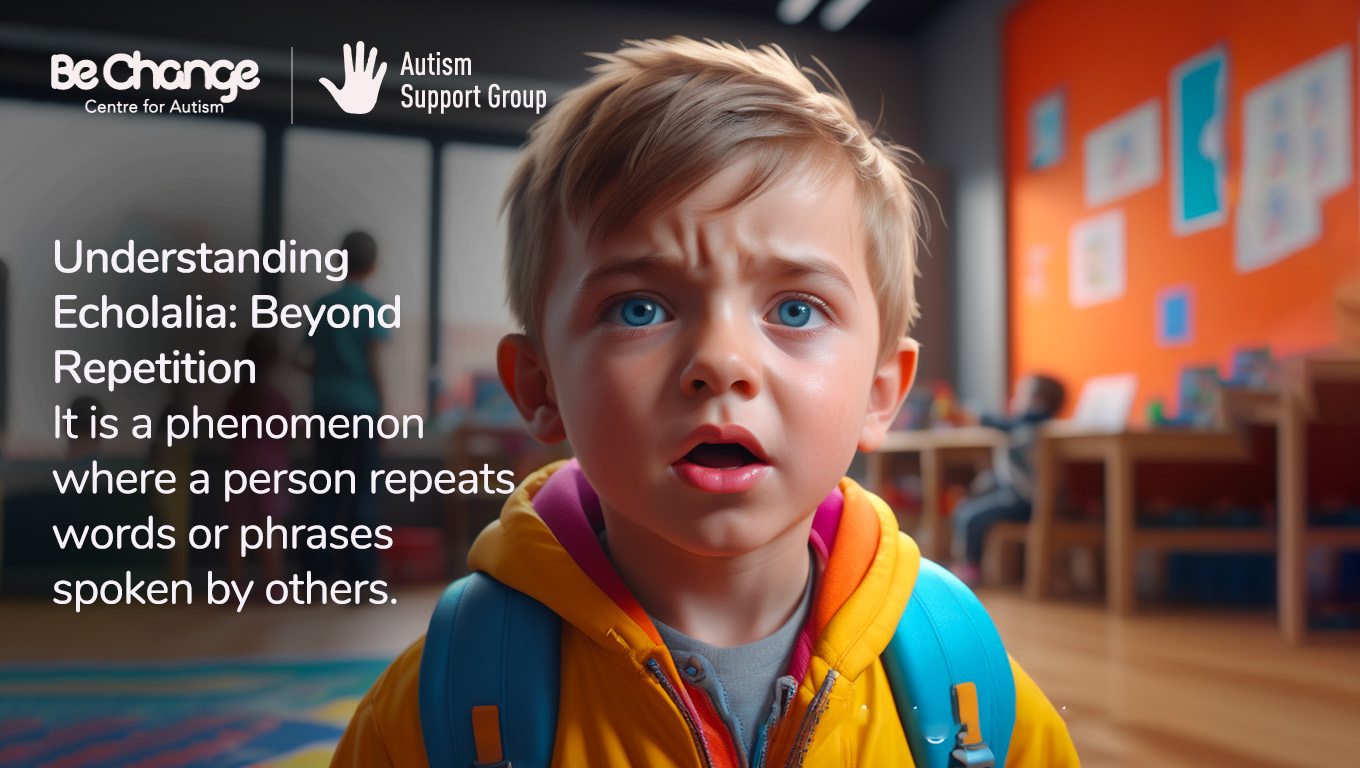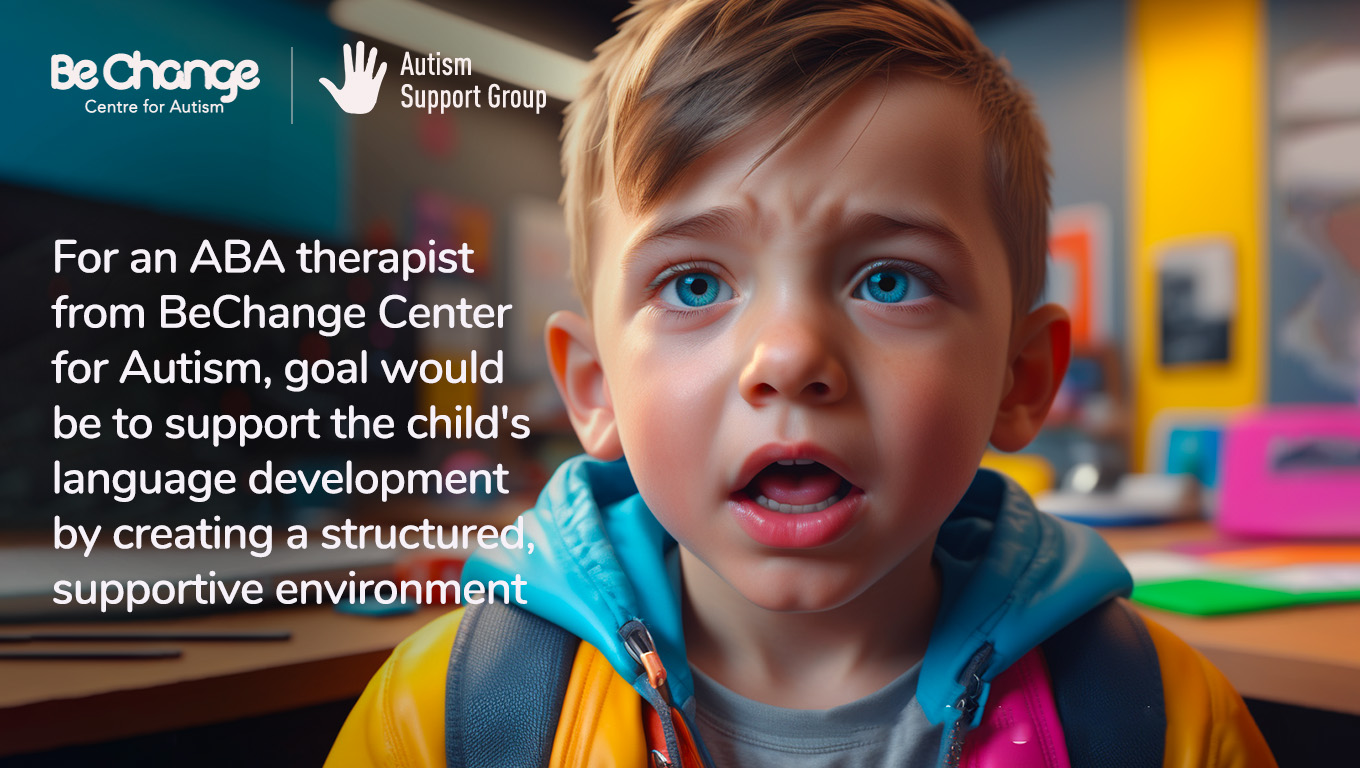Echolalia, often observed in individuals on the autism spectrum or those with certain neurological conditions, is a phenomenon where a person repeats words or phrases spoken by others. This repetition can occur immediately after hearing the words (immediate echolalia) or after a certain period (delayed echolalia). At first glance, it might appear as mere repetition, but it holds significant clues about the individual’s cognitive and communication processes. It’s essential to understand that echolalia is a form of communication, even though it may not align with typical conversational norms.
Join Autism Support Community in Facebook
When encountering echolalia, it’s crucial to look beyond the surface repetition. Consider the context, tone, and surrounding cues. Is the individual echoing as a way to express a need, seek comfort, or engage with others? By carefully observing these subtleties, caregivers and professionals can gain valuable insights into the individual’s emotions and intentions.
-
Immediate Echolalia:
Immediate echolalia involves the immediate repetition of words or phrases spoken by others. For example, if you ask, Do you want juice? a child with echolalia might respond, Do you want juice? instead of answering the question directly.
-
Delayed Echolalia:
Delayed echolalia occurs when the repetition happens after a significant delay. The child might hear a phrase or sentence and then repeat it hours, days, or even weeks later. It could be a line from a favorite movie or something they heard during a specific situation.
-
Mitigated Echolalia:
Mitigated echolalia involves the repetition of phrases, but the child modifies the original phrase to communicate a specific need or desire. For instance, if a child repeats, Want cookie, they might be expressing a desire for a cookie.
 Distinguishing echolalia from a child’s understanding of language involves careful observation and analysis:
Distinguishing echolalia from a child’s understanding of language involves careful observation and analysis:
-
Contextual Understanding:
A child’s ability to understand and use language appropriately within different contexts is crucial. For example, if a child uses a repeated phrase to appropriately respond to a question, it might indicate an understanding of its meaning rather than mere repetition.
-
Functional Communication:
Analyzing whether echolalia serves a communicative purpose is essential. If the child uses echolalia to request, comment, or express feelings, it demonstrates a level of understanding beyond mere repetition.
-
Response to Questions:
Pay attention to how the child responds to questions. If they can answer questions appropriately, even if echolalia is present in their response, it suggests a level of comprehension.
-
Adaptability:
Children with echolalia might repeat phrases, but they might also modify these phrases to fit different situations. If a child can adapt their echolalic utterances to convey different meanings, it shows a deeper understanding of language.
-
Language Progression:
Track the child’s language development over time. If there is progress in their ability to use and understand language, it indicates that their understanding is expanding beyond mere repetition.
Navigating Behavioral Disorders: A Sensitive Approach
Individuals displaying echolalic behavior often have underlying challenges related to communication and social interaction. These challenges can be frustrating, both for the individual and their caregivers. In navigating behavioral disorders like echolalia, it’s vital to adopt a patient and empathetic approach.
Creating a supportive environment involves active listening and acknowledging the individual’s attempts at communication. Encourage them to express themselves, even if it involves repetitive phrases. Instead of correcting or dismissing the repetition, focus on the emotions behind the words. Are they anxious, excited, or seeking reassurance? Understanding the emotions driving echolalia can guide caregivers and therapists in tailoring their responses effectively.
 Seeking Solutions: Strategies for Coping with Echolalia
Seeking Solutions: Strategies for Coping with Echolalia
-
Speech and Language Therapy:
Speech therapists play a crucial role in developing tailored interventions. They work on expanding the individual’s vocabulary and language comprehension. These professionals employ strategies that focus on breaking down complex sentences into simpler forms, making it easier for the individual to express themselves meaningfully.
-
Visual Aids and Social Stories:
Visual aids, such as picture cards and visual schedules, provide a tangible way for individuals to communicate their needs. Social stories, which depict social situations in a structured manner, can help individuals understand appropriate responses. These tools serve as anchors, offering predictability in social interactions.
-
Positive Reinforcement:
Positive reinforcement techniques involve rewarding positive behaviors and efforts to communicate effectively. By praising the individual for using words or phrases appropriately, caregivers reinforce the desired behavior. This positive feedback creates a motivating environment, encouraging the individual to engage in purposeful communication.
Unraveling the Role of ABA Therapy: A Beacon of Hope
Applied Behavior Analysis (ABA) therapy stands out as a comprehensive and systematic approach to addressing echolalia and other behavioral challenges. ABA therapists conduct detailed assessments to understand the triggers and patterns of echolalic behavior. Based on these assessments, personalized intervention plans are developed.
-
Functional Communication Training (FCT):
FCT is a core component of ABA therapy. It focuses on teaching individuals alternative ways to express their needs and desires. ABA therapists identify the function of echolalia – whether it serves as a form of communication, self-stimulation, or another purpose. By replacing echolalic phrases with functional language, individuals learn to communicate effectively, reducing their reliance on repetitive speech.
-
Reinforcement Strategies:
Positive reinforcement lies at the heart of ABA therapy. ABA therapists identify the individual’s preferred rewards, which can range from verbal praise to tangible items. When individuals use appropriate language instead of echolalia, they receive these rewards, reinforcing the desired behavior. Over time, this reinforcement strengthens the individual’s communicative skills, reducing echolalic tendencies.
-
Social Skills Development:
ABA therapy integrates social skills training into its programs. Individuals learn to interpret facial expressions, body language, and social cues, enabling them to engage in reciprocal conversations. ABA therapists create structured social scenarios, allowing individuals to practice these skills in a supportive environment. As social skills develop, individuals gain confidence, reducing their reliance on echolalia as a communication tool.
In essence, understanding echolalia requires a multifaceted approach. By acknowledging the individual’s unique communication style, employing effective strategies, and leveraging evidence-based interventions like ABA therapy, we can empower individuals to move beyond repetitive speech, fostering genuine and meaningful communication. It’s a journey that demands patience, empathy, and unwavering support, ultimately leading to a world where everyone’s voice is heard and understood.
Join Autism Support Community in Facebook : https://www.facebook.com/groups/SupportAutism
An ABA Therapist’s role involves careful observation and analysis of a child’s behavior. Observe the child in various situations, noting how they use language, especially echolalic speech. Through systematic observation and analysis, identify patterns in their communication.
Create structured learning environments to encourage functional communication. This might involve using visual supports, social stories, and other communication tools tailored to the child’s needs. During therapy sessions, provide positive reinforcement and support to encourage the child to move beyond mere echolalia to more meaningful and spontaneous communication.
Additionally, collaborating with speech therapists and other professionals would be essential. Speech therapy techniques can be integrated into ABA sessions to target specific communication challenges, helping the child develop meaningful language skills.
Certainly, understanding what constitutes echolalia and what does not is crucial, especially for parents of newly diagnosed children. As a senior ABA therapist, my role involves providing clear explanations and examples to help parents grasp these concepts.
Here’s what is not echolalia to a parent:
I understand your concern. It’s important to distinguish between typical behaviors and echolalia, especially when children are learning to communicate. Echolalia specifically refers to the repetition of words or phrases without understanding their meaning. However, not all repetitions are echolalia. Let me provide you with some examples of what is not echolalia to help clarify.
Babbling and Early Speech Development
When very young children babble or repeat sounds and syllables, it’s a natural part of their language development. For instance, when a baby says ‘mama’ or ‘dada’ without necessarily understanding the meaning, it’s a typical phase of early speech development. This repetition is not echolalia but rather a way for the child to explore and experiment with sounds.
Lack of Understanding or Distraction
Sometimes, children might repeat words or phrases simply because they didn’t fully understand what was said, or they might be distracted. For example, if you ask a child if they want juice, and they repeat ‘juice’ without reaching for it or showing any other signs of interest, it could be due to a lack of understanding rather than echolalia. Similarly, if the child is engrossed in a toy or a game and repeats words without context, it might be because their attention is elsewhere, not necessarily echolalia.
Imitative Play and Social Learning
Children learn by imitating the words and actions of others. When they engage in pretend play and use phrases they’ve heard, it’s a sign of their social and imitative learning, not necessarily echolalia. For instance, if a child pretends to be a doctor and says phrases they heard during a doctor’s visit, it shows their ability to imitate and role-play, which is an essential part of social development.
While echolalia involves the repetition of words or phrases without understanding, many instances of repetition in young children are part of their natural learning process. It’s crucial to observe the context, the child’s comprehension, and their overall development. If you have concerns about your child’s communication skills, our team is here to assess, support, and guide both you and your child through this journey. Together, we can work towards effective communication and social development for your child.
In summary, distinguishing echolalia from a child’s understanding of language involves considering context, functionality, adaptability, and language progression. For an ABA therapist from BeChange Center for Autism (Bangalore, Karnataka), goal would be to support the child’s language development by creating a structured, supportive environment and collaborating with other professionals to provide comprehensive care.
Know more about Curriculum In Action



